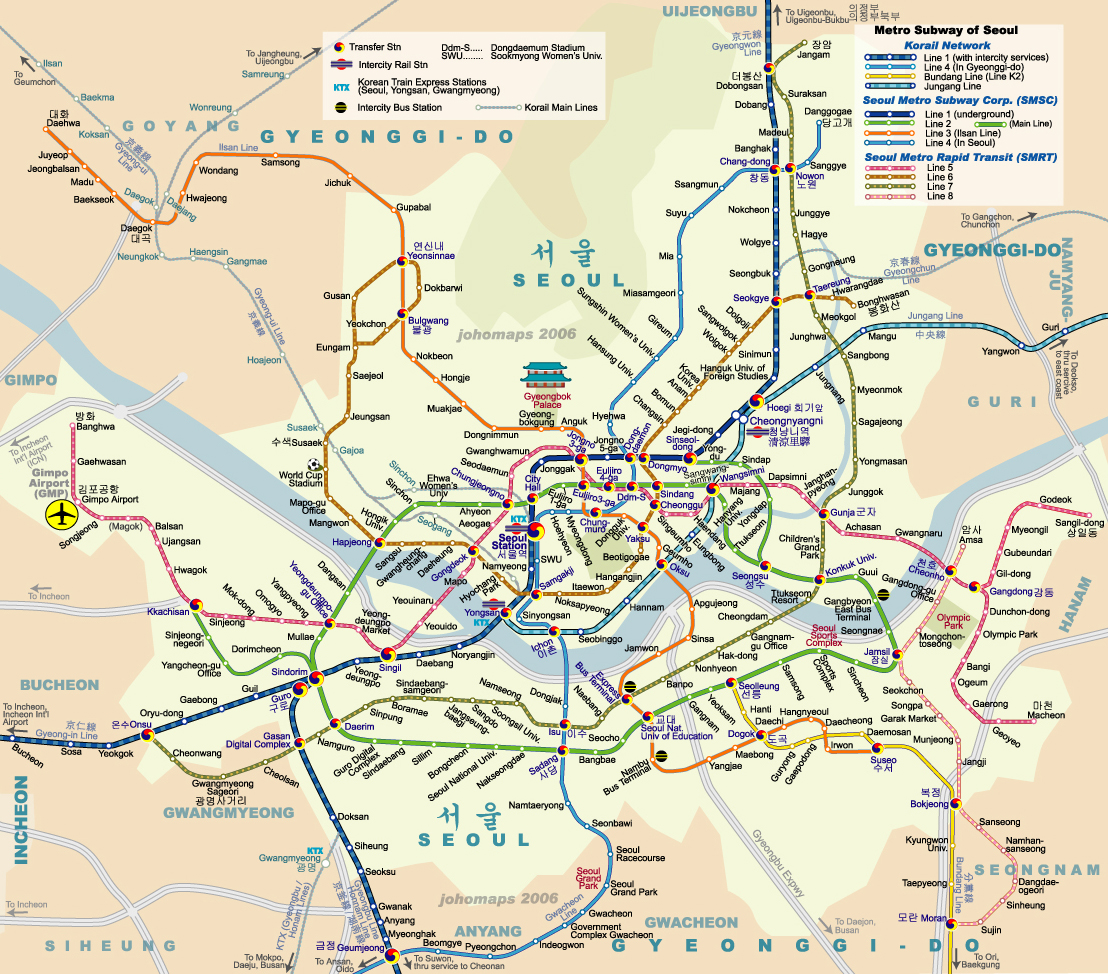
The Seoul Metro system map
On request from Pat, here's a post about public transit! It will be mainly pictures, since I have taken public transit on about two round trips. Overall, my experience was good - the system is intuitive to use and well marked in both Korean and English. (Well, I assume it's well marked in Korean...)
What impresses me about the system -- and keep in mind that my points of reference are Vancouver, Toronto and Montreal, not other real metropolitan transportation systems -- is its extent. I live in Anyang, which isn't really part of Seoul but some ways south, out of Seoul's administrative area. Yet Anyang is served by two subway lines and has at least three stations, one within a block from my house. Trains seem to come at least every 10 minutes. And, while the subway stops running around 1am, we were able to fairly easily catch a bus directly from Gangnam (a neighbourhood in Seoul where we had dinner and drinks) to Beomgye Station in Anyang at 2am. Given that it's a 4-mon-won ($35) cab fare, the bus makes it practical to go into town for fun on a weekend.
Pat - not sure exactly what you want to know, but you can ask questions in the comments, and I may follow up later when I have more experience with the system. In the meantime, here are some more pictures. I'm off to Costco to stock up the kitchen!

Passengers exiting a train at the station

A train interior. Yes, there are seats, but I didn't take pictures of them due to the people sitting in them.



This makes me nostalgic...
ReplyDeleteAre there barriers up that open only when the train arrives and doors open? Those weren't there before, so it's weird to see.
Neat! The trains are really neat. It's clear the tunnels were designed around the trains, which is really neat for a vancouverite (since our Expo tunnels predate skytrain by a good 40-50 years).
ReplyDeleteSeems like a lot of headroom in the trains too, though low doorways, probably have to duck I imagine?
the metro map in the train is REALLY neat, it's really hard to effectively caption a complex light rail system onto a board like that. Look at our trains, the Canada Line doesn't even mention Expo/Millennium on it's boards, and the Canada Line on the Expo/Millenium maps is completely out of scale and looks like an afterthought.
It really flattens out what in reality is a very large web system.
And I love the ease by which subways traverse, and it's all economical thanks to the density! Give Vancouver a hundred years and we might reach that level of light rail depth, we seem to add a new line approximately once a decade, so we'd need a hundred years of catchup!
How is the frequency of trains? Are they fully automated or driver operated? Do the tickets work on a zone type system, or are they system wide? Can you buy time as you go, or is it a set rate for a ticket?
I'm guessing some of these questions you may not be able to answer...
I'm just fascinated by public transit...
Yes, but only at the busier stations. They're (jokingly?) called the suicide barriers, but I think they're actually to prevent people from falling (and getting pushed by the crowd at rush hour) onto the track.
ReplyDeleteTo answer Pat's questions (How is the frequency of trains? Are they fully automated or driver operated? Do the tickets work on a zone type system, or are they system wide? Can you buy time as you go, or is it a set rate for a ticket?)
ReplyDeleteFrequency of trains - the ones on Line 4 (which goes north-south through Seoul) seem to come about every 10 min or so - probably more during busy hours. Some trains don't go all the way to the end of the line though, instead stopping just out of Seoul's city borders.
I'm pretty sure the trains are fully automated.
Tickets are interesting. If you're buying a single ticket, you have to select the station where you're getting off at the ticket dispenser, and it charges you depending on how much distance you're travelling. I think single tickets range between 900 and 3000 won (roughly $0.90 to $3.00). Tickets are more than just paper, so you also have to pay a ticket deposit, which is refunded when you return the ticket at your destination.
You can also buy a "T-Money" card and load it up with cash. It works like a debit card for transit - you swipe it when you enter the system and it takes off the base fare of 900 won, then you swipe it when you exit and it deducts an additional amount according to how far you went. You get a slight (100 won / trip, I think) discount over buying individual tickets.
Now, that's for the subway. Busses work a little differently (I paid 2500 won, or $2.50 for mu late-night bus ride) but I'm not sure exactly how. I'll tell you more when I have figured it out.
I can buy that they're suicide barriers, I know that they've had to install those in several cities to prevent people from jumping on the rails. I think your explanation makes sense as well, though! Probably some combination of the two...
ReplyDeleteYeah, except that people could just ride the train down a few stops and get out at a station without them...
ReplyDelete